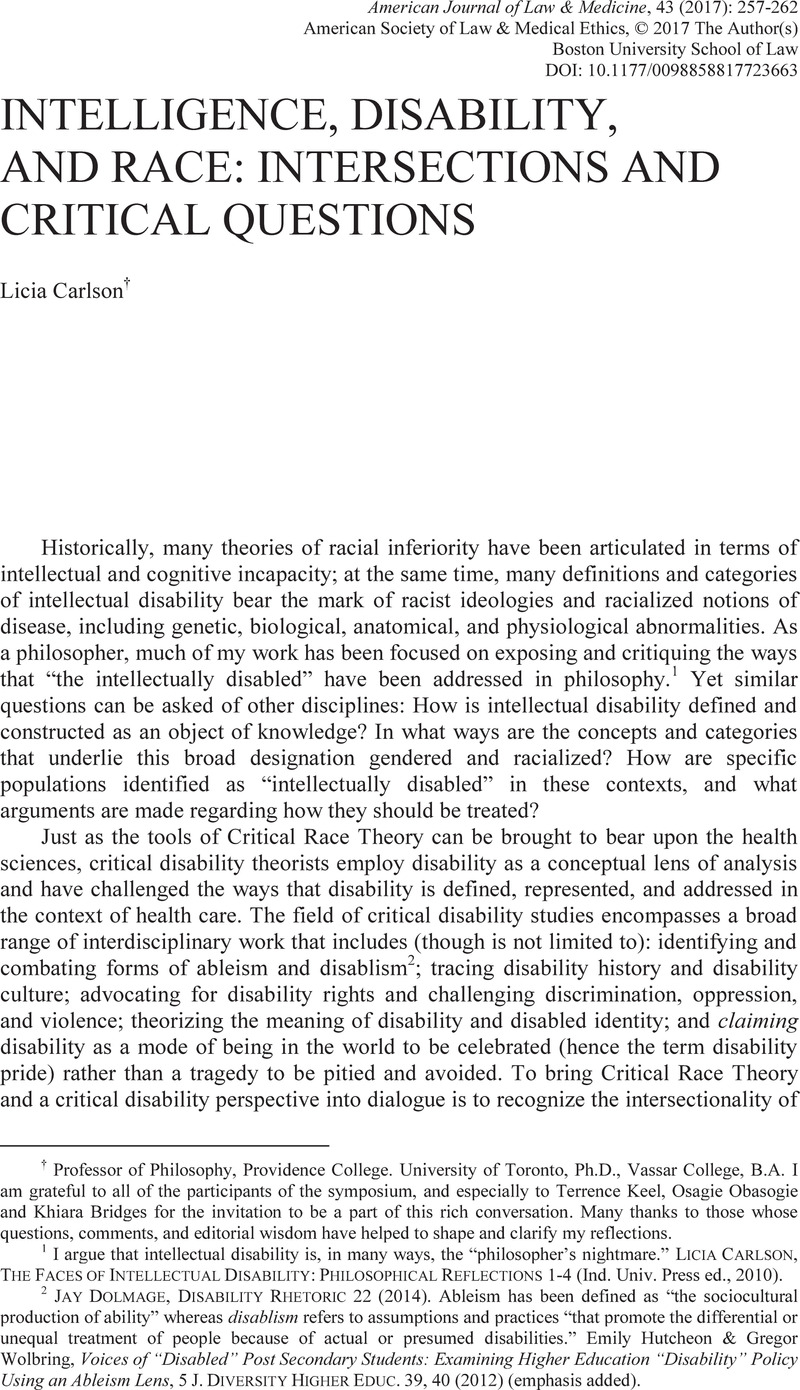Article contents
Intelligence, Disability, and Race: Intersections and Critical Questions
Published online by Cambridge University Press: 06 January 2021
Abstract

- Type
- Articles
- Information
- American Journal of Law & Medicine , Volume 43 , Issue 2-3: Critical Race Theory & the Health Sciences , May 2017 , pp. 257 - 262
- Copyright
- Copyright © American Society of Law, Medicine and Ethics and Boston University 2017
References
1 I argue that intellectual disability is, in many ways, the “philosopher’s nightmare.” Licia Carlson, The Faces of Intellectual Disability: Philosophical Reflections 1-4 (Ind. Univ. Press ed., 2010).
2 Jay Dolmage, Disability Rhetoric 22 (2014). Ableism has been defined as “the sociocultural production of ability” whereas disablism refers to assumptions and practices “that promote the differential or unequal treatment of people because of actual or presumed disabilities.” Hutcheon, Emily & Wolbring, Gregor, Voices of “Disabled” Post Secondary Students: Examining Higher Education “Disability” Policy Using an Ableism Lens, 5 J. Diversity Higher Educ. 39, 40 (2012)CrossRefGoogle Scholar (emphasis added).
3 Nirmala Erevelles, Race, in Keywords for Disability Studies 145, 147 (Rachel Adams, Benjamin Reiss & David Serlin eds., 2015).
4 See Nirmala Erevelles, Disability and Difference In Global Context, 147-171 (Palgrave MacMillan ed., 2011) (“forging a linkage between Critical Race Theory (CRT) and materialist disability studies.”). See also Christopher M. Bell, Blackness and Disability: Critical Examinations and Cultural Interventions (2011) (providing additional examples).
5 I recognize that this is a broad term. The American Association on Intellectual and Developmental Disability defines intellectual disability as “a disability characterized by significant limitations in both intellectual functioning and in adaptive behavior, which covers many everyday social and practical skills. This disability originates before the age of 18.” Definition of Intellectual Disability, American Association on Intellectual and Developmental Disabilities, http://aaidd.org/intellectual-disability/definition#.WOu2AmXufFI [https://perma.cc/TH25-LRFD]. However, the questions raised in this article can be asked of a broader range of disabilities that affect behavior and cognition.
6 Id.
7 IQ scores, for example, are not part of the AAIDD definition of intellectual disability, but are still part of some classifications in the DSM-V and employed in legal contexts. Id.
8 Carlson, supra note 1, at 113.
9 For example, “feebleminded women” in the early twentieth century were defined, at certain points, as women who had more than one illegitimate child. The transgression of moral norms was itself evidence of intellectual inferiority and thus of intellectual disability. See id. at 53-83.
10 See id. at 92-3.
11 See id.
12 See generally Carlson, Licia, Who’s the Expert? Rethinking Authority in the Face of Intellectual Disability, 54 J. Intell. Disability Res. 58, 65 (2010)CrossRefGoogle ScholarPubMed (providing greater explanation of these questions).
13 Alexandra Minna Stern examines the ways that both race and disability are addressed by genetic counsellors (who are predominately white women). See generally Alexandra Minna Stern, Telling Genes: The Story of Genetic Counseling in America (The Johns Hopkins Univ. Press ed., 2012)..
14 Similar questions can be asked about passing as non-disabled. See Allison C. Carey, The Sociopolitical Contexts of Passing and Intellectual Disability, in Disability and Passing: Blurring the Lines of Identity (Jeffrey A. Brune & Daniel J. Wilson eds., 2013).
15 Carlson, supra note 1, at 164.
16 See Magaña, Sandra et al., Racial and Ethnic Health Disparities Among People with Intellectual and Developmental Disabilities, 54 Intell. and Developmental Disabilities 161, 172 (2016).CrossRefGoogle ScholarPubMed
17 Id. at 166.
18 Id.
19 See Graaf, Gert de et al., Estimation of the Number of People with Down Syndrome in the United States, 19 Genetics Medicine 439, 441 (2017).CrossRefGoogle ScholarPubMed
20 These questions are raised and debated in The Hastings Center Report Special Issue from 2015. See Parens, Erik & Applebaum, Paul S., An Introduction to Thinking about Trustworthy Research into the Genetics of Intelligence, 45 Hastings Center Rep. (Special Issue) S2 (2015).CrossRefGoogle ScholarPubMed
21 Roberts, Dorothy, Can Research on the Genetics of Intelligence be “Socially Neutral?”, 45 The Hastings Center Rep. (Special Issue) S50, S52 (2015).CrossRefGoogle Scholar
22 Id. at S53.
23 See Gert de Graaf et al., supra note 19, at 446 (“As a consequence of elective terminations, the (native born) population of DS has been reduced by an estimated 19% as of 2010.”).
24 For debates regarding the disability critiques of prenatal testing more generally, see Georgetown Univ. Press, Prenatal Testing and Disability Rights (Erik Parens & Adrienne Asch eds., 2000).
25 See Dorothy Roberts, Fatal Invention: How Science, Politics, and Big Business Recreate Race in the Twenty-First Century 223 (The New Press ed., 2011).
26 Sara Goering, Conformity Through Cosmetic Surgery: The Medical Erasure of Race and Disability, in Science and Other Cultures 172, 172 (Robert Figueroa & Sandra Harding eds., 2003).
27 See Jones, R.B., Parental Consent to Cosmetic Facial Surgery in Down’s Syndrome, 26 J. Med. Ethics 101, 102 (2000).CrossRefGoogle ScholarPubMed A more extreme example can be seen in the “Ashley treatment,” a form of growth attenuation for children with severe disabilities that has sparked intense controversy and moral outrage. See Carlson, supra note 1, at 3.
28 See Stacy Clifford Simplican, The Capacity Contract: Intellectual Disability and the Question of Citizenship 54-58, 70 (Univ. of Minn. Press ed., 2015).
- 2
- Cited by


